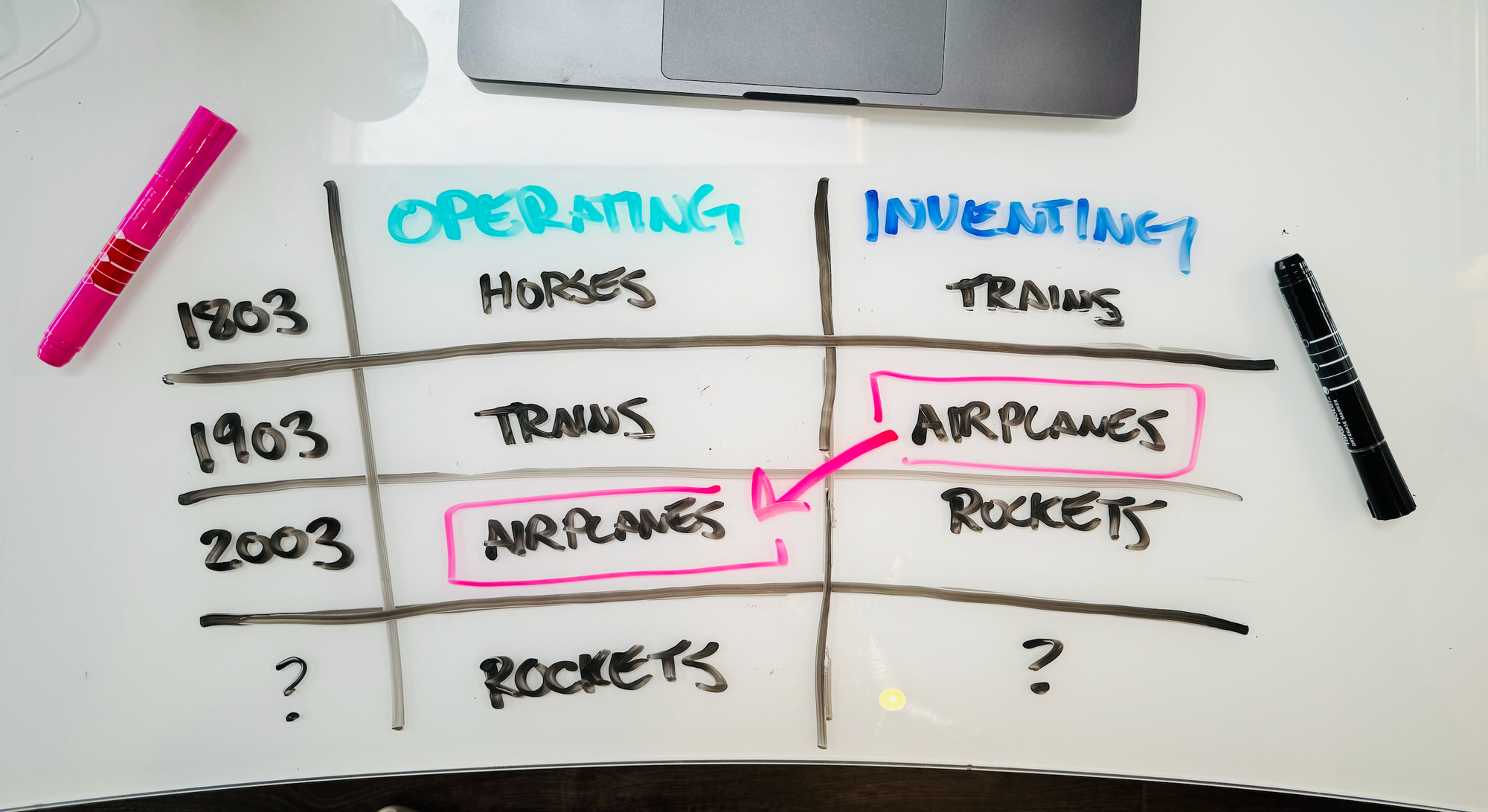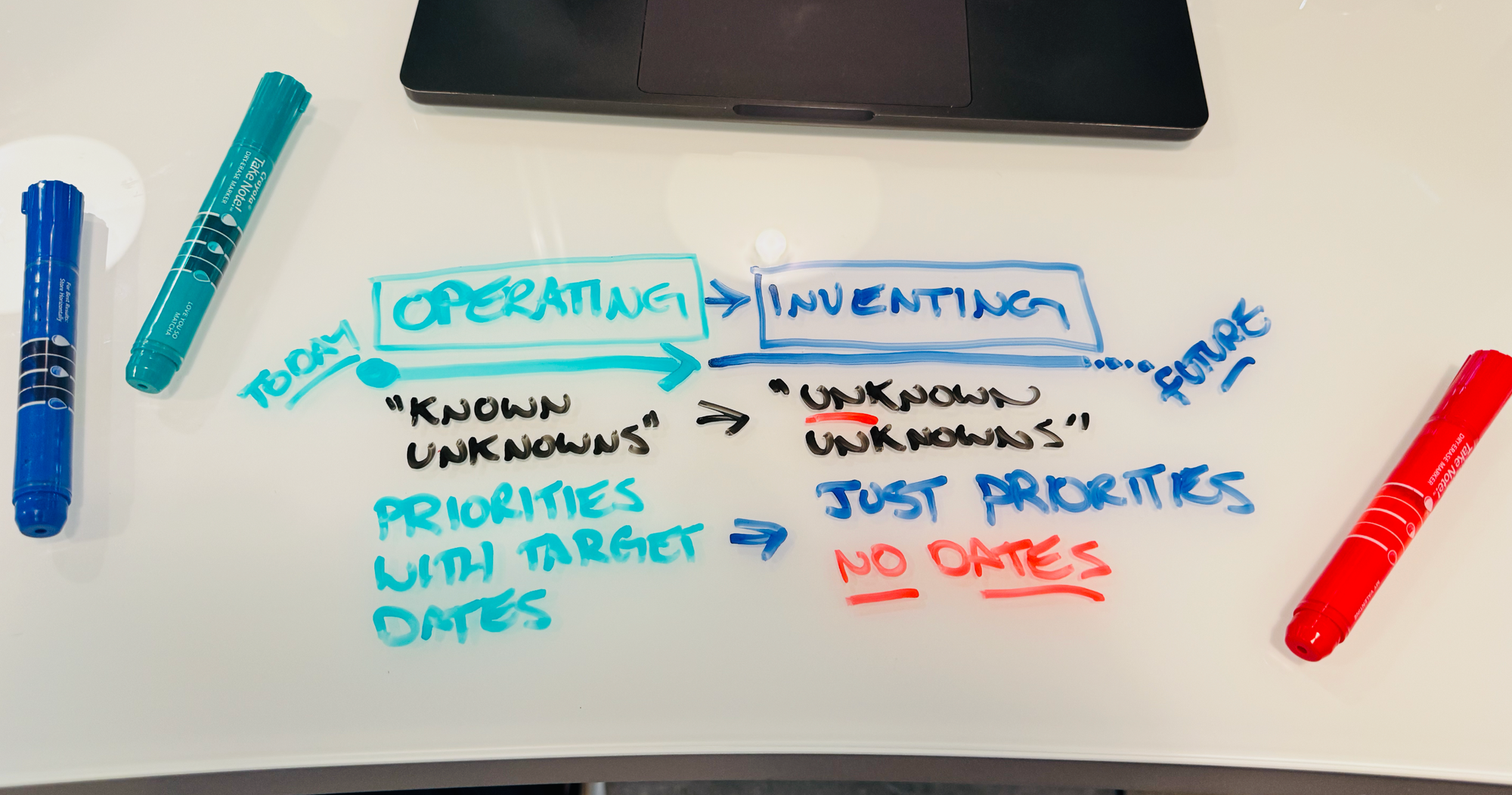Why we keep missing due dates and deadlines -- and how to fix it.

This is a post about deadlines, due dates, why we keep missing them, and a way fix that for yourself, your team, and your company by differentiating between two very distinct modes that we often conflate as one with consistently deleterious effects: Operating vs. Inventing.
But we'll get back to that, because all this starts with a story about human flight.
Humans have dreamt about flying since we first looked up at birds in the sky. In Greek mythology, Daedalus, a skilled inventor, creates wings made of feathers and wax for himself and his son Icarus. We all know what happened to Icarus.
In ancient China, there were stories of humans attempting flight using kites and other rudimentary flying devices. During the Middle Ages, Leonardo da Vinci conceptualized and sketched flying machine designs that included ornithopters, which mimicked the flapping of bird wings.
So why did controlled, powered human flight first happen in Kitty Hawk on December 17, 1903? Why not 1803? Or for that matter, 803, or thousands of years before that?
You wouldn't think it, but in order to create an airplane, you need a telegraph and X-ray machine. Well, specifically, you need an induction coil, which wasn't created with the intent of hurtling humans through the air in a tube. It was created to turn low DC voltage into high voltage, which was used to pioneer the creation of X-ray machines in the early 1800s, and to enable telegraphs to send messages over longer transmission lines.
The induction coil also happens to be really handy to create high-voltage spark to ignite the fuel-air mixture in an engine, which happened in the late 1800s. But even the first engines weren't created for airplanes – they were huge, industrial machines, much too large for flight and not even conceived for doing so.
So to create an airplane, you need an engine. A small, compact one. To create an engine you need an induction coil. To create an induction coil, you need a telegram. And so on. None of the people who were inventing any of these items connected any of their inventions to joining the ranks of birds flying above them.
And that's not it – by a long shot. It turns out that to create airplanes, you also need bicycles. Clement Ader, Samuel Pierpont Langley and others tried to fly in the late 1890s but couldn't make compact enough engines and didn't think about planes needing to "balance" in the air like the Wright brothers did. An airplane, like a bicycle, needs to be actively controlled to maintain stability – bikes and airplanes both fall over if not in motion. The Wright brothers developed three-axis control for their aircraft including wing warping for roll, elevator for pitch and rudder for yaw.
I love this analogy because it beautifully spans the arc of invention. So although the Wright brothers are the recognized heroes in our story, many non-obvious inventions had to be layered in first to give the Wright brothers an opportunity to become the inventors who would produce the successful outcome. Non-obvious inventions like the telegram were required for the near-adjacent inventions like three-axis control to be possible.
Part of the reason we get confused when we start setting deadlines for things is that we don't employ a sophisticated, shared vocabulary to distinguish between the stages in the creation process and we have a really hard time understanding which stage we're in.
Once inventions become routine and we iron out the unknowns, we enter into an entirely different realm: Operating. Here's how I think about the difference, sticking with the airplane analogy:

In 1903, airplanes were anything but routine. But even just 50 years later – and definitely by 2003, we could reliably move airplanes into the "operating" category – if you book a flight on a certain date, you can reliably assume you'll get there safely the same day. No inventions are required to make that happen.
For clarity, I prefer to draw two hard bookend boundaries at each end of the "operating to inventing" spectrum: A timeline with "today" on the far left and "future" on the far right.

"Today" operating space: You've de-risked things. You've done it before. You know what's going to happen, generally. You're making just-another-widget in the factory – the millionth one to come off the assembly line. You're making the same TacoTuesdays you always make on Tuesday nights. You're driving the same route to work as you do every day. Even the surprises aren't that surprising: Unexpected traffic on the way to work? You knew that was a possibility – it's raining, after all, and you know it might take you 20 minutes longer to get to work. Making tacos on Thursday night this week instead of Tuesday? You've got this.
- When you're firmly in the operating space, you can absolutely set deadlines for things, because you know how to plan, you know what the dependencies are, you can even anticipate and plan for the things that might go wrong. I call this
Getting [x] done by [y] date. - You can have confidence in your projections – and even if you're off, you can confidently reset expectations (it's raining today – I'll be 20 mins late!) with a new date commitment based on the new information, because you know how to contextualize it.
Pro-tip: If I pointed you to this post from my ReadMe, you'll know how much I care about resetting expectations when you miss a date. I care way less about you getting the date exactly right than about you updating me if you can't.
"Future" inventing space: On the other end of the spectrum is the future. The farther we look out into the future, the less certainty we'll have about what we can get done by which date. This is especially true if we're not just doing the same things over and over that we've been doing – if we're moving from "operating" to "inventing."
- In the inventing space, you cannot set dates because you don't know what you don't know. You will be surprised by roadblocks, dependencies, and other gotchas that you just cannot plan for – if you could plan for them, by definition, you wouldn't be inventing, you'd be operating.
The advanced version: Deeper nuance in operating and inventing spaces
As per the Wright brothers example above, there are actually two flavors of inventing. Near-adjacent inventions and non-obvious inventions. If you don't yet see the difference, just run the airplane invention exercise with any other meaningful invention – the original baseline inventions that made the celebrated invention possible had no forward-looking connections to it:
- Computers required vacuum tubes, which were invented in the early 1900s to turn AC current into DC current.
- Trains required steam engines, which were invented in the early 1700s to pump water out of mines.
- Phones required electromagnets, which were invented in the early 1800s out of a curiosity to study different types of magnets. And the list goes on.
If you want to geek out on near-adjacent vs. non-obvious inventing, I highly recommend Why Greatness Cannot Be Planned: The Myth of the Objective. There's a lot to this distinction, and the authors share great ways to plan and measure success in both.
There are also two flavors to the operating space: Operating and innovating.

The more nuanced way to think about this framework would be:
- Operating: You're working with known knowns, like making the widgets, TacoTuesdays, and driving to work every day as per above.
- Innovating: You're layering in unknown variables, but you can still largely plan around them. Maybe you decide to take your bike to work instead of your car – you're innovating around how you get to work. But you still have a pretty good idea of how long it'll take to bike vs. drive. We'll call these "known unknowns" because you know that the variability is coming and you'll need to account for it.
- Near-adjacent inventing: You're now working on new things that nobody (or at least you + a lot of Googling) has done before. Maybe you're putting two new pieces of software together in a way that's never been done before to produce a new system. Or maybe you're building a rocket for the first time. You're inventing, but you're leveraging other past inventions that have made it able for you to create step-change outcomes.
- Non-obvious inventing: You're inventing things for some purpose that end up serving an entirely different, unexpected purpose. You may often feel like you've failed because your invention didn't service it's intended purpose, but later someone else (or you) may find that your invention was critical to their near-adjacent inventing success.
Putting it all together: Getting better at setting priorities and deadlines
The "advanced" version above is a lot to grok, especially when, in business meetings, the executive (and yes, it's usually the executive) asks by when can you have [x] delivered? with zero thought, attention or even conceptualization as to which bucket the question falls into.
So again, for simplicity, let's just scope things down to the operating vs. inventing spheres and hope that we can achieve better outcomes in meetings.
Here's how I think about it: The trick is to understand where the boundary lies between operating and inventing. This is the part that we humans typically get wrong. We by definition have a really hard time understanding when we've moved from "known unknowns" to "unknown unknowns." This is the skill that's hard to hone. This is where the magic is when you start to get it right.
Operating: You've done it before – or if not done it exactly, you've done enough work in the space to know what to expect; what will likely go wrong, and how to estimate the work required to deliver output.
- Work primarily in a priority-based queue, because you always run out of time, so get the most important work done first.
- OK to set
[x] delivered by [y] dates→ and if you miss the date, just be really disciplined about resetting expectations.
Inventing: You don't know what you don't know. If you're doing it right, you'll be inventing in the near-adjacent space where a number of other non-obvious inventions will be coming together in ways that allow you to produce step-change outcomes. If you're not, you'll hit what feel like dead ends but might end up being foundational inventions for someone else (or you, later) to capitalize on in unexpected ways.
- Work only in a priority-based queue
- Don't try setting
[x] delivered by [y] dates– you'll just be disappointing those around you and breaking trust. Instead, make sure you have clarity and shared understanding around what the important priorities are. Work on them for as long as they're the top priorities – either you make progress on them, or the priorities change and you adjust accordingly.- Push back on executives that want you to pull a date out of a hat. A great way to do this is to scope down the ask until you can pull it from the invention into the operating space. You might not know when you can deliver that new feature by – especially if it requires putting new technologies together in ways that have never been done before, but you probably do know what you can get done today. Find that boundary between the two spaces and make that your limit for date commitments. Beyond that, just stick to aligning on priorities. Send them this blog post if you need to.
I'd love to hear what strategies you and your teams use to successfully set deadlines and deliver projects on time.
The importance of asking for help
When you're working in the inventing space, you'll hit unforeseen "gotchas" that you can't plan for – if they were known you would be, by definition, in the operating space, not the inventing space.
But here's the important thing: What is inventing for you could be innovating or even operating for someone else. Just because you haven't done it before doesn't mean nobody has done it before.
One of the best ways to de-risk a project the fastest is to find others that have done it before, and find out from them what it is that you don't know you don't know.
That doesn't mean they'll be able to tell you how to get something done – especially if they weren't successful at it. But they may very well be able to tell you how not to get it done.
One more thing...
Not only is is it hard for humans to find the fuzzy line between operating → inventing modes and apply different spaces of thought to them, but the inverse is also true:
Right now, we're living in a period where rockets are moving from the "inventing" to the "operating" column, and it's fascinating to watch it play out. This blog post from 2021, "Starship is still not understood," provides a great education on how SpaceX will make rocket flight routine and the impacts it will have on NASA and others who (as of 2021) didn't seem to yet fully understand this shift was happening.
Other areas where we're moving from "inventing" to "operating" spaces in the next few years and most don't realize it:
- Likely: Fully autonomous self-driving cars
- Probably: Achieving artificial general intelligence
- Possibly: Achieving longevity escape velocity